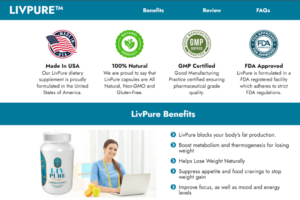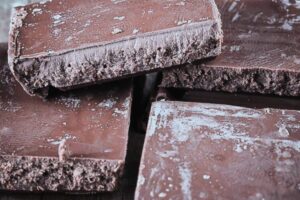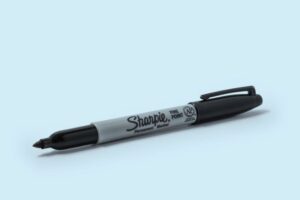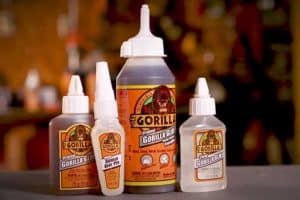What happens when mixing bleach and ammonia? Is it safe, or is it toxic? In this article, I’ll describe what happens when mixing these two cleaning agents and why it is not safe.
For most people, ammonia and bleach can be easy choices for disinfection and cleaning. After all, they’re cheap, effective, and easy to use. If you read the labels on your household cleaning materials, most of them will contain either one.
But, mixing these two chemicals is very dangerous and will cause more harm than good. It is important to know that bleach and ammonia should never be mixed together. So what happens when you mix bleach and ammonia? Why is it toxic?
Mixing bleach and ammonia creates toxic gases called chloramines. Chloramine vapor can form into hydrazine. These gases are very harmful when inhaled. Chloramines are known to be respiratory irritants, while hydrazine is known to cause headaches, nausea, vomiting, and even seizures.
Exposure to these toxic gases produced from mixing bleach and ammonia can cause many symptoms ranging from skin irritation to being unconscious and even death.
Read on to learn more about the effects of combining bleach and ammonia, as well as safety tips for using both.
Mixing Bleach and Ammonia – What Happens and Why Is It Toxic?
We all have cleaning and disinfecting solutions at home. And we use it for a lot of surfaces, such as kitchen counters, floors, doorknobs, light switches, bathroom tiles, and fixtures. If you want a germ-free home, you need to clean your house regularly.
There’s a huge array of cleaning and disinfecting products on the supermarket shelves, right? The question is, are they all safe to mix together? Bleach and ammonia, specifically, are two very common chemicals used for disinfecting. But did you know that mixing ammonia and bleach can produce noxious gases that are very harmful to people when inhaled?
Yes, mixing bleach and ammonia can actually be very dangerous and poisonous. It can even kill you!
What Exactly Is Ammonia?
Ammonia is a type of colorless gas that has a characteristic pungent smell. It is commonly found in nature and the human body because it is essential for making proteins. Ammonia can be easily liquified, and this is the form used for many industrial materials and household cleaning products. It can be effective in removing fat, stains, and stubborn grease but isn’t proven to kill germs. It is, however, used to disinfect things against E. coli bacteria.
When using ammonia as a cleaning agent, always follow the dilution instructions – 1 cup of ammonia to a gallon of water. Wear protective gloves when handling ammonia. Use it in well-ventilated areas only.
What Exactly Is Bleach?
There are three types of bleach: chlorine bleach (sodium hypochlorite), oxygen bleach (hydrogen peroxide), and bleaching powder (calcium hypochlorite). Most cleaning and disinfecting products use chlorine bleach.
But, all kinds of bleach are chemicals used to remove or lighten colors by oxidation. They also work well as a disinfectant because they effectively kill germs like viruses, bacteria, and fungi.
When using ammonia for disinfecting, follow specific dilution instructions. You can have a dilution of 1:10 to 1:100, with bleach being the lower number in the ratio. As with most chemicals, it should only be used in well-ventilated areas and handled while wearing gloves as it can burn and sting the skin on contact.
So, why is mixing ammonia and bleach dangerous? Why is it toxic to combine these two chemicals together?
Mixing bleach and ammonia will create very toxic gases called chloramines. Chloramine, which is a respiratory irritant, has the potential to form hydrazine. So, exposure to a mixture of bleach and ammonia can cause mild to severe and fatal effects, depending on the amount of exposure.
Does Hydrogen Peroxide Make Your Skin White?
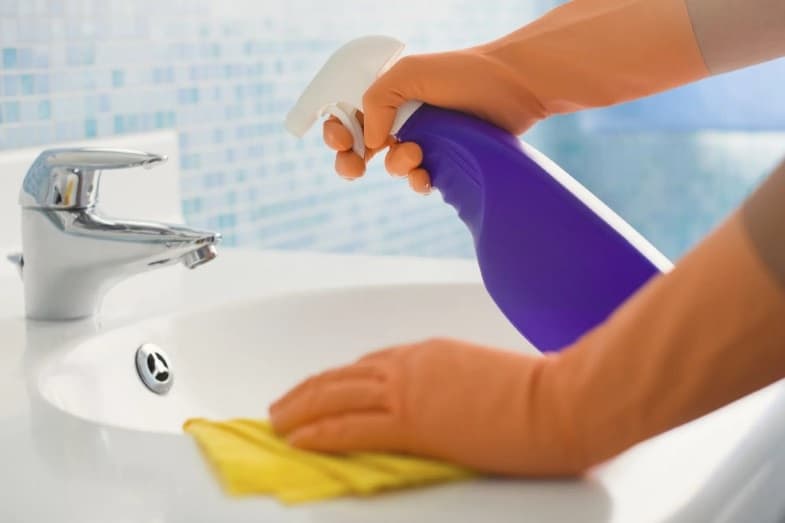
If you’re exposed to chloramine gases from mixing bleach and ammonia, you may experience the following symptoms:
- Coughing
- Wheezing
- Dizziness
- Shortness of breath
- Chest pain
- Burning, watery eyes
- Irritation to throat and nose
- Pneumonia with fluid in the lungs
- Death (for very high levels of exposure)
What to Do If You Have Been Exposed to Chloramine Gases from Mixing Bleach and Ammonia?
Once exposed, you need to act and move quickly. The longer you stay exposed, the more severe the damage can be.
- Remove yourself from the area immediately. You can’t call for help if you get overwhelmed by the toxic fumes, which can happen quite fast.
- Move to a well-ventilated area as quickly as you can.
- Call 911 or your emergency service number if you have difficulty breathing or a wheezing attack.
- If you’re able to breathe and don’t deem it necessary to call 911, call your local poison control center.
- Call 911 immediately if you see someone exposed and unconscious. Quickly move the person to a well-ventilated area. Do not expose yourself to the toxic fumes, as you may endanger yourself, too.
- Open the windows and doors when it is safe to do so to dissipate the fumes.
- Rinse your eyes, take a tepid shower, and change your clothes, as your clothes may have very well absorbed the fumes. Moreover, air out your clothes very well before laundering them.
- Get on the phone with your local poison control center, and they will tell you what to do for cleanup and disposal. Follow their instructions.
Know the Uses of Bleach and Ammonia
Bleach and ammonia are not bad chemicals if you know how to use them properly. Always remember that you cannot mix these two chemicals together because they will produce toxic fumes. Let’s look at what they can be used for.
Bleach
1. Bleach Kills Most Household Germs and Bacteria
Bleach is more of a disinfecting agent than a cleaner. Say, for example, you want to clean and disinfect your kitchen counter. The best way to do this is to first wipe it down with soap and water. After it dries, you can spray diluted bleach on it and then wipe it down again with a clean cloth. Bleach rapidly loses effect if the surface is dirty, so it is always best to clean the surface first.
2. Bleach Is Also Good for Laundry
Dilute according to the label and run your clothes in the wash with a bleach solution before doing your laundry. Always check clothing labels first to see if you can apply bleach to them.
3. The Main Use of Bleach Is for Disinfecting Surfaces
But here’s one trivia – did you know that you can add 1/4 tsp. of bleach to a vase filled with water and flowers so that they stay fresh for up to a week? The bleach in the water fights off bacteria that make the flowers wilt fast.
Dangers of Mixing Hydrogen Peroxide With Bleach
Ammonia
1. Widely Used in Agriculture as a Natural Fertilizer
Ammonia is an efficient refrigerant gas and can also be used as a purifier of water supplies.
2. Used in Household and Industrial Cleaning Agents
You can find this chemical in window cleaners, floor and tile cleaning materials, and many more.
3. Ammonia Is an Effective Cleaner Because It Removes Scum, Fats, Oils, and Grease Easily
Although ammonia effectively works as an all-around cleaner, it isn’t effective in killing viruses. It will work in killing some bacteria, including E. coli. However, many manufacturers also create quaternary ammonium compounds for industrial settings like hospitals and restaurants. This kind of ammonia can kill most viruses.
Both bleach and ammonia are usually safe to use when diluted and in small amounts for disinfecting most non-porous surfaces. The key is to handle the chemicals carefully and never to mix bleach and ammonia. Read the label on the bottles of cleaning and disinfecting agents you have, and never combine any of these cleaning solutions.
Tips for Safely Handling Ammonia and Bleach
As discussed, bleach and ammonia are both very effective and cost-efficient disinfecting chemicals. You can use both on various porous surfaces. But these two chemicals can also produce gases, which are respiratory irritants. Don’t be scared, though. The key is in knowing how to handle these chemicals safely.
Mixing bleach and ammonia is a bad idea, but you can safely use them separately. Here are some tips for the safe handling of both ammonia and bleach:
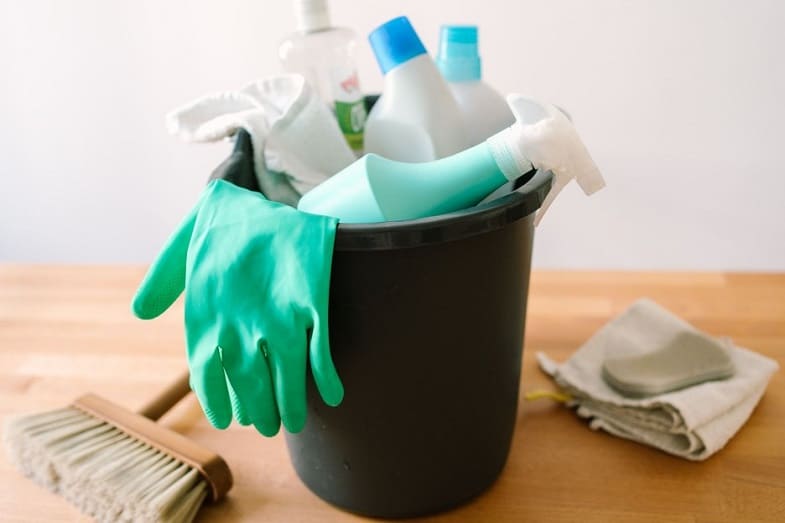
Use Protective Clothing
- Wear gloves when handling products with bleach and ammonia. Rubber or neoprene gloves work best as they are thicker than latex or plastic. These chemicals are also skin irritants and can cause redness and a burning sensation upon skin contact.
- Wear goggles or even a face shield to protect your eyes and face from any splatters.
- You should wear protective garments or clothing, such as long-sleeved shirts, long pants, and closed-toe shoes. Use specific protective clothing such as chemical suits and aprons when handling large amounts of bleach and ammonia.
Proper Storage
- Keep products with bleach and ammonia ingredients in their original bottles. This way, you can always read and reread the product label.
- Keep out of children’s reach at all times. If you store them in a cabinet or drawer accessible to children, lock the cabinet door.
Only Use in Well-ventilated Areas
- If you need to use these chemicals in an enclosed space like small bathrooms, turn on an overhead vent, keep the door open, and use a fan to let the air circulate. You can also wear a mask and goggles to protect yourself from the fumes.
Other Useful Tips
- Always follow the ‘how to use instructions’ on the label. These instructions may also include proper dilution of the product. When diluting, remember always to pour the chemicals into the water and never the other way around.
- Do not clean any surfaces that could possibly have urine on it like diaper pails, pet cages, and litter boxes with bleach. Urine contains ammonia in small amounts. Use soap and warm water instead.
- Always rinse off anything you wipe down with bleach or ammonia.
- For disinfecting surfaces in your homes, do not use bleach or ammonia daily. Some studies have shown that using bleach and ammonia often can decrease lung function over time. It can also trigger asthma and allergies.
- Do not smoke while using these products. Moreover, do not have any uncovered food or drink near these chemicals.
- Wash your hands properly by using soap and water after you handle anything with bleach or ammonia. When these chemicals remain on surfaces, they will continue to emit fumes. Exposure to these fumes causes respiratory problems, especially in children, including pets.
- Do not ingest any product that has bleach or ammonia.
- Again, DO NOT MIX ANY PRODUCT THAT HAS BLEACH WITH ANY PRODUCT CONTAINING AMMONIA. Such a combination will create toxic fumes that are very dangerous when inhaled.
Conclusion – Mixing Ammonia and Bleach
Knowing how to handle cleaning agents, such as bleach and ammonia, is very important, as discussed above. Both are found in many industrial and household cleaning products. If safely used, they really work well on sanitation and disinfection.
But never mix bleach and ammonia; better yet, to be really sure, just never mix these two cleaning agents together. Mixing ammonia and bleach leads to the production of very toxic gases called chloramines. These toxic gases can cause several symptoms ranging from mild to severe to coma and even death.
Always read product labels and instructions and follow what it says. Yes, we all want a cleaner and germ-free environment but never compromise your safety and health.


